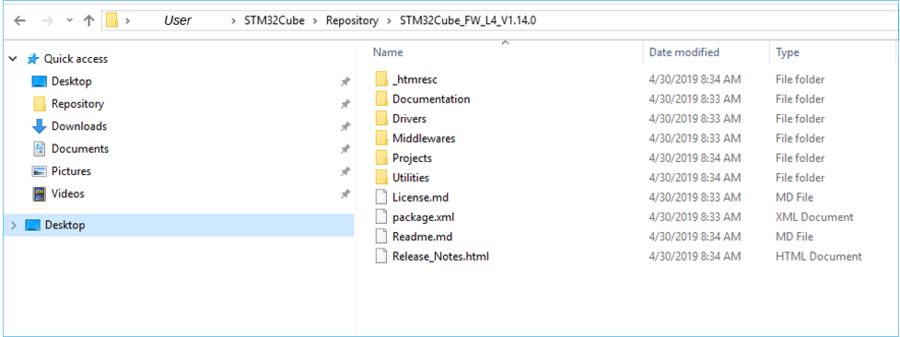This article explains to new customers and users how to go further with STM32Cube MCU Package (software package).
1. STM32Cube MCU Package (software package)
1.1. Project creation instructions
Once STM32CubeMX (or STM32CubeIDE) is installed and an STM32 MCU is selected, the corresponding STM32Cube MCU Package is automatically downloaded and saved on the PC at the following path: C:\users\yourname\STM32Cube\repository.
The user must then follow the instructions provided by STM32CubeMX in order to:
- create a project
- build the software
- customize the software and generate the corresponding code
- execute the code on the board.
To open an existing project, double-click the *.ioc file so that STM32CubeMX automatically opens the project and its source files.
For example, browse to C:\users\yourname\STM32Cube\repository\STM32Cube_FW_G0_V1.3.0\Projects\NUCLEO-G071RB\Examples\GPIO\GPIO_IOToggle and double-click GPIO_IOToggle.ioc file.
The STM32Cube MCU Package can also be downloaded from the following locations:
- www.st.com
- or GitHub
1.2. Additional useful information
A lot of information are available within the STM32Cube MCU Package.
First read STM32CubexxGettingStarted.pdf available under the ...\STM32Cube_FW_xxx\Documentation directory.
Then explore the STM32Cube MCU Package folders in the below order to find additional information:
- ...\STM32Cube_FW_xxx\Drivers\STM32xx_HAL_Drivers
- Help on HAL/LL drivers
- HAL release notes
- HAL and LL drivers source files
- ...\STM32Cube_FW_xxx\Drivers\BSP
- BSP drivers for all supported boards
- Drivers for all the external components used on the supported boards
- ...\STM32Cube_FW_xxx\Drivers\CMSIS
- CMSIS files that define peripherals register declaration, bit definition and address mapping
- CMSIS files that define peripherals register declaration, bit definition and address mapping
- ...\STM32Cube_FW_xxx\Middlewares
- Middleware libraries
- Middleware release notes
- Middleware libraries
- ...\STM32Cube_FW_xxx\Projects
- STM32CubeProjectsList.html, an exhaustive list of all examples/applications/demonstrations supported for each board
- Then organized by board / feature, a set of
- templates
- applications
- demonstrations
- examples
All the examples, applications and demonstrations are provided for several compatible IDEs.
2. Next steps
 Development zone Get help to start developing applications and share projects |
 Software tools For a first contact with the tools |
 Training zone Improve your knowledge on STM32 ecosystem through online trainings, MOOC, ... |
